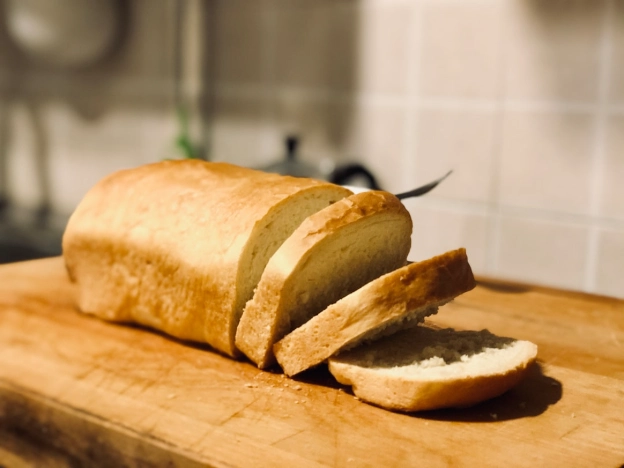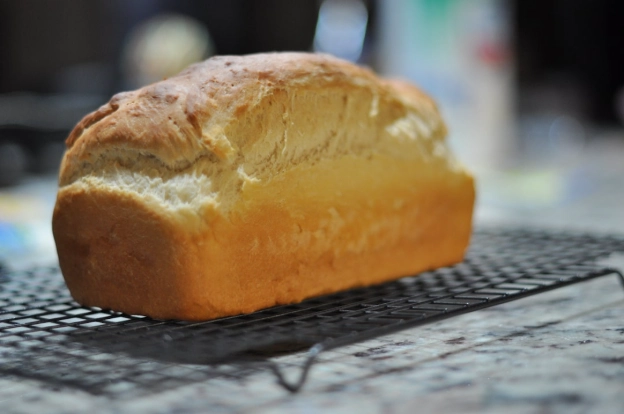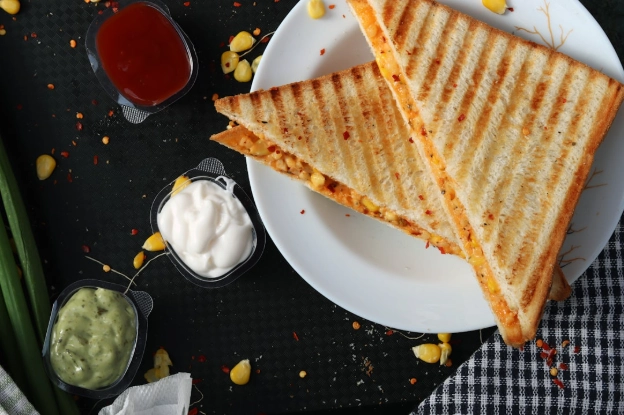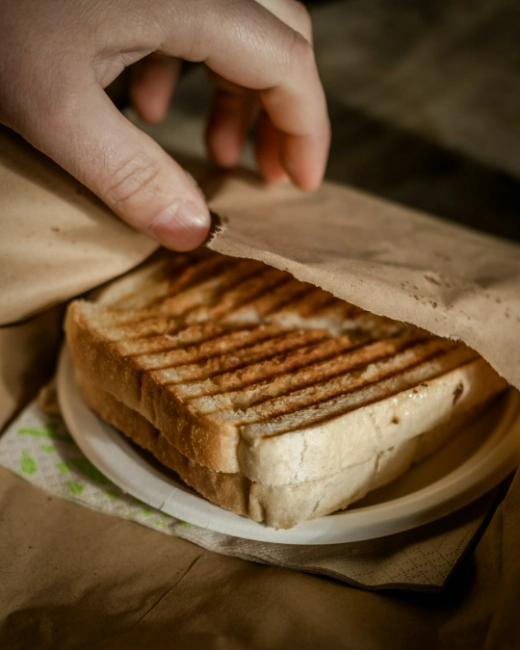Soft Sourdough Sandwich Bread (Pullman Loaf, Pain de Mie)

-
Ingredients & Equipment
-
Step-by-Step
-
What makes sourdough sandwich bread better than regular white sandwich bread?
-
Pro Tips
-
Troubleshooting
-
Variations & Substitutions
-
Storage & Serving
-
FAQ
- What is a Pullman loaf (pain de mie)?
- Can I cold-proof overnight?
- Which pan size do I have?
- Is sourdough really “healthier”?
- My crust gets too dark - why?
-
You Might Also Like These Posts
This is the soft, sliceable sourdough loaf you want for everyday toast and stacked sandwiches: gently sweet, milk-enriched, and baked in a Pullman (lidded) pan for that classic four-square shape. Sourdough brings deeper grain flavor, better keeping quality, and a more satisfying caramelization on the crust -so a simple buttered slice tastes like more than “just” white bread. Recent research also points to improved nutrient bioaccessibility and protein digestibility with sourdough fermentation.
A Pullman-style sourdough sandwich bread is a naturally leavened, milk-enriched loaf baked in a straight-sided pan (often with a lid) for a square shape and tender, even crumb. Sourdough adds complex flavor, better browning, and stays soft longer than yeasted white bread.
New to sourdough? See How to Make a Sourdough Starter from Scratch: A Foolproof Guide and How to Feed Your Sourdough Starter for Perfect Baking Results for timing and activity cues.
The fresh smell is just heaven!
Ingredients & Equipment
Ingredients (metric + imperial)
Bread flour: 480 g (≈ 3¾–4 cups; cup conversions are approximate)
Active sourdough starter (72% hydration): 110 g (≈ ½ cup)
Eggs: 120 g (≈ 2 large)
Milk: 135 g (≈ ½ cup + 1 tbsp) or 70 g milk + 70 g heavy cream
Sugar: 60 g (≈ ¼ cup + 1 tbsp)
Fine sea salt: 15 g (≈ 2½ tsp)
Soft unsalted butter: 60 g (≈ 4 tbsp)
Note: Enriched doughs include proteins and sugars that boost Maillard browning - expect a beautifully golden crust. For the science, see our post The Science Behind the Maillard Reaction: Unlocking the Secret of Browning and Flavor, and Britannica’s overview.
Equipment
Mixing bowl (or stand mixer with dough hook)
Pullman / sandwich loaf pan: small 2x ~9×4×4 in (20×11×11 cm). If your pan is larger, you can bake it in one, but be sure to adjust the baking time accordingly. For background on Pullman/pain de mie.
Little rustic, but still tastes amazing!
Step-by-Step
Autolyse (1 hour)
Whisk milk, eggs, sugar with the flour until no dry spots remain. Rest for 30-60 min.Mix in the starter
Add 110 g active starter; mix until homogeneous.
Add 15 g salt; mix 2–3 min more.Add butter
Knead in the soft butter in 3–4 additions until the dough is smooth, elastic, and slightly tacky with a satiny sheen. Dough should be stiffer than lean sourdough - this is right for a tight, sandwich-friendly crumb.Bench rest → Lamination
Rest 30 min, then laminate (gentle letter-fold on a lightly moistened counter) to trap extra air and align gluten.Bulk ferment
Cover and ferment at 22–24 °C (76–78 °F) until nearly doubled in size. Timing depends on starter strength; use volume and feel over the clock.Divide & pre-shape
Divide into 4 equal pieces; pre-shape tight rounds. Rest 20 min.Roll & coil
Roll each piece to a rectangle just as wide as the pan, keeping internal bubbles intact. Tightly roll each into a log and nestle the four logs snugly in the greased pan.Final proof
Proof covered at 22–24 °C (76–78 °F) until the dough sits ~1 cm (⅜ in) below the pan rim. In cooler rooms, you can retard overnight slightly warmer than the fridge (butter-rich doughs don’t love very cold proofing).Bake with steam
Preheat to 160 °C (320 °F). Mist the top or brush with water; steam the oven (as you would for sourdough boules). If you have a Pullman-style loaf pan, this is the time to put the top on.
Bake 15 min with steam → vent steam and continue 20–30 min until deep golden.
Large pans might need longer. (Every oven is different - adjust as needed for your oven’s performance.)
Food-safety note (eggs in enriched doughs): general guidance recommends baking egg-containing dishes to ≥ 71 °C / 160 °F internal. Bread crumb temp will exceed this when fully baked.
Cool & slice
De-pan after 10 min; cool at least 1 hour before slicing for the cleanest crumb.
What makes sourdough sandwich bread better than regular white sandwich bread?
Natural fermentation adds deeper flavor, improves keeping quality, and tends to brown more evenly thanks to organic acids and residual sugars - yielding toast that smells and tastes richer. Studies also suggest improved nutrient bioaccessibility and protein digestibility.
I mean... this just makes me hungry!
Pro Tips
Proof by height, not the clock: stop ~1 cm below the rim for a square top (with lid) or gentle dome (no lid).
Don’t skimp on mixing: enriched, buttery dough needs a full gluten network for that thin, sliceable crumb.
Steam early, dry late: steam boosts rise; vent to set color and crust.
Starter strength wins: refresh your starter as in How to Feed Your Sourdough Starter for Perfect Baking Results for the most reliable rise.
Troubleshooting
Dense/crumbly slices: under-mixed gluten or under-proofed final rise. Mix longer, proof to the height cue.
Blowouts at the sides: shaping too loose - roll tighter and seal the seam.
Pale top: insufficient venting; extend the dry bake by 5–10 min.
Greasy mouthfeel: butter added too early or dough too warm; add butter only after gluten develops and keep dough ~22–24 °C (74–78 °F).
Variations & Substitutions
Milk-and-cream version (richer): swap the 135 g milk for 70 g milk + 70 g heavy cream for extra tenderness.
Honey-kissed loaf: replace 20–30 g sugar with honey; expect slightly faster browning; richer, earthier taste.
50% whole-wheat: replace half the flour with finely milled whole-wheat; increase milk by 10–20 g if the dough feels tight.
With lid (true Pullman): bake lidded for the first 25–30 min, remove lid to finish color. Background on Pullman/pain de mie here.
Perfect for an everyday sandwich!
Storage & Serving
Room temp, airtight: 2–3 days (sourdough stays soft longer).
Freeze (sliced & wrapped): up to 3 months; toast straight from frozen.
Rewarm/toast: 180 °C / 350 °F oven 5–8 min or toaster as desired.
Great uses: classic sandwiches, grilled cheese, croque-monsieur, French toast - the enriched crumb caramelizes beautifully (hello Maillard!).
FAQ
What is a Pullman loaf (pain de mie)?
A straight-sided, lidded pan bread with minimal crust and a very even, fine crumb - ideal for uniform slices and toast.
Can I cold-proof overnight?
Yes, but very cold temps slow butter-rich doughs unevenly. Use a slightly warmer chill (≈8–10 °C / 46–50 °F) or shorten the retard to 6–8 hours.
Which pan size do I have?
Small Pullman ≈ 9×4×4 in is for about 400-450 g of dough; large ≈ 13×5×5 in is for about 900-950 g of dough. If larger, scale the formula to the size and extend the baking time.
Is sourdough really “healthier”?
“Healthier” depends on context, but fermentation is associated with improved nutrient bioaccessibility and protein digestibility compared to straight-yeast white bread.
My crust gets too dark - why?
Sugar, milk, and eggs accelerate browning. Lower the final-phase temp by 10–15 °C (15–25 °F) or tent loosely with foil.
You Might Also Like These Posts
The Science Behind the Maillard Reaction: Unlocking the Secret of Browning and Flavor
How to Feed Your Sourdough Starter for Perfect Baking Results
Folding Dough: Why It Matters and How to Do It Right
How to Make a Sourdough Starter from Scratch: A Foolproof Guide
How to Make Homemade Sourdough Bread: A Beginner’s Guide
The Ultimate Guide to Sourdough Focaccia
-
Ingredients & Equipment
-
Step-by-Step
-
What makes sourdough sandwich bread better than regular white sandwich bread?
-
Pro Tips
-
Troubleshooting
-
Variations & Substitutions
-
Storage & Serving
-
FAQ
- What is a Pullman loaf (pain de mie)?
- Can I cold-proof overnight?
- Which pan size do I have?
- Is sourdough really “healthier”?
- My crust gets too dark - why?
-
You Might Also Like These Posts




